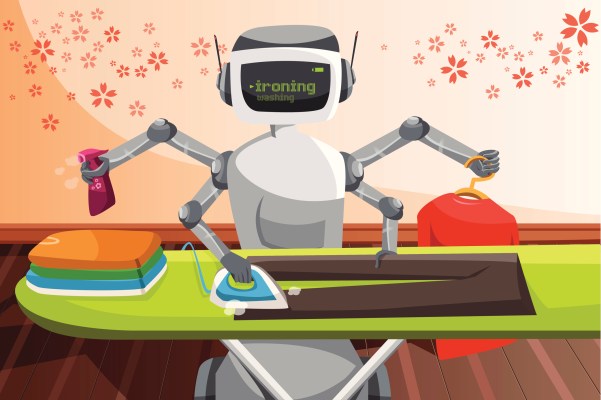Robots intrigue us. We all like them. But most of us don’t love them. That may dramatically change over the next 10 years as the “robot nanny” makes its way into our households.
In as little time as a decade, affordable robots that can bottle-feed babies, change diapers and put a child to sleep might be here. The human-machine bond that a new generation of kids grows up with may be unbreakable. We may end up literally loving our machines almost like we do our mothers and fathers.
I’ve already seen some of this bonding in action. I have a four-foot interactive Meccanoid robot aboard my Immortality Bus, which I’ve occasionally used for my presidential campaign. The robot can do about 1,000 functions, including basic interaction with people, like talking, answering questions and making wisecracks. When my five-year-old rides with me on the bus, she adores it. After being introduced to it, she obsessively wanted to watch Inspector Gadget videos and read books on robots.
My two daughters (the other one is two years old) have always been near technology, and both were able to successfully navigate YouTube watching videos on iPhones by the time they were 12 months old. Yet, while my kids love the iPhone, and they want to use it regularly, it doesn’t bond them to technology in a maternal sense like the Meccanoid robot does. More importantly, the smartphone doesn’t bond them to technology in an anthropomorphic sense — where one gives technology human attributes, like personalities.
Robot nannies will replace real nannies like the automobile replaced the horse and cart.
My kids instinctively know the iPhone is a tool. But Meccanoid is a friend. If you kick the robot, leave it in the rain or lock it away in the closet, my kids will freak out. To them, the robot is personal — and the love is real.
If some of this reminds you of Rosie the Robot — the cleaning, cooking nanny robot from the Jetsons — you’re not alone. Humans will soon regularly engage with machines as fellow companions in life, giving psychologists, anthropologists and Congress new ideas to consider. There is already chatter all across the internet in the transhumanist community about humans wanting the right to marry machines — and all that goes with that. In fact, in the Transhumanist Bill of Rights I delivered to Washington, DC, we explicitly aim to give future conscious beings personhood — as well as other rights covered by the 1948-adopted United Nations Universal Declaration of Human Rights.
Despite the thorniness of some of the issues between humans and robots, the reason we are entering this robot age is because of one simple fact: functionality. Robots will make our lives far easier. In fact, the robot nanny is a prime example: It will be adored by parents — and likely much more so than the human nannies who are known to call in sick, show up to work late and, on occasion, sue their employers when they hurt themselves on the job. Robot nannies will replace real nannies like the automobile replaced the horse and cart — allowing parents much new free time and opportunity to pursue careers.
One major factor going for the development of robot nannies is their cost effectiveness. I’ve been either watching my kids or hiring nannies for the last five years. About $200,000 later (which is what 8-hour weekday childcare costs in San Francisco for five years), it’s safe to say a robot nanny is not going to cost as much as I’ve spent. And once my kids are old enough and no longer need immediate supervision, I’ll be left with the robot to sell or give to a family in need.
But essential questions remain: Will some robots be allowed to watch kids when parents go out for the night or off to work — and other robots not? Who will make that determination? The parent? The manufacturer? The government?
Will robots that can perform CPR, put out fires, squish poisonous spiders and perform the Heimlich maneuver on a choking child be authorized while others are not? Will robots that can detect smoke and carbon monoxide, where others can’t, make the “nanny-worthy” grade?
And then come the questions ethicists and programmers are already facing with driverless cars. If an autonomous vehicle is forced into a choice to hit a young family of five or an old man, what does it choose? Nanny robots may one day be programmed with similar instructions and values.
But what if a robot nanny is watching twins, and both start choking at the same time? Which child will it choose to help first? Will programmers allow parents to program which child should be helped first?
The questions are endless. I suspect, like the U.S. Department of Transportation’s National Highway Traffic Safety Administration’s Federal Motor Vehicle Safety Standards and Regulations, a robot equivalent will have to be established.
It’s been years since the American household has gotten a new fixture that all households must have. One of the last major ones was the computer — and now nearly 85 percent of American households have one. I suspect nanny robots will be one of the next commonplace items we have in our homes. And our love for them will grow as they influence and play an integral part of the next generation’s upbringing.
